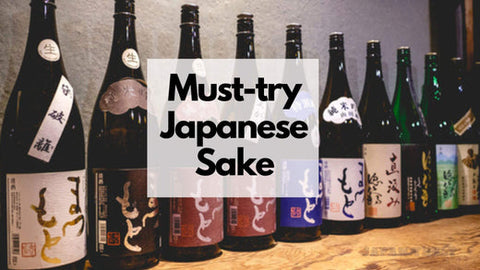When exploring the vast array of Japanese sake, it's essential to understand the different types. Notably, four major categories serve as a starting point: Junmai, Daiginjo, Honjozo, and Ginjo.
Understanding Sake Varieties
Sake has several grades, each with unique traits:
- Junmai: Pure rice sake, no added alcohol, can offer a full-bodied taste with higher acidity.
- Ginjo: Made with rice polished to at least 60%, featuring a light and fruity profile.
- Daiginjo: An elevated Ginjo, with even more polished rice, creating a refined and aromatic beverage.
- Honjozo: A tad of brewer's alcohol added, giving a smooth finish and lighter flavor.
Top Japanese Sake Selections
Dassai Junmai Daiginjo 50
Originating from the Dassai brand in the Yamaguchi prefecture, this sake is lauded for its fruitiness and smooth finish, characterized by its rice essence and cultured bouquet.

Ideal for a range of palates, including those new to sake, this variety uses Yamada Nishiki rice and is versatile in pairing with diverse cuisines.
Despite its former name, the current iteration known as Dassai Junmai Daiginjo 45 maintains its appeal.
Hakkaisan Tokubetsu Junmai
Esteemed for its mildly sweet and harmonious flavors, Hakkaisan sake utilizes spring water from Mount Hakai and Gohyakumangoku rice.

Its almond and vanilla notes culminate in a creamy texture that complements an array of foods and is particularly beginner-friendly with its 15.5% alcohol content.
Kubota Senju Ginjo "1000 Long Lives’’
Recognized for continuous flavor innovation, the Kubota brand offers a sake with a light, refreshing profile, and an almost clear appearance.

The "1000 Long Lives" bestows palate-pleasing notes of dried fruit and spices with a candy-like, dry finish, and pairs wonderfully with grilled dishes.
Murai Family Nigori Genshu
With roots in the Edo period, the Murai Family sake presents a gently sweet and creamy profile.
Its Nigori style, featuring aromatic sediments, contributes to a delightful cloudy appearance and is best enjoyed chilled, boasting a 19.8% alcohol content for a stronger sip.
Gekkeikan Sake
Established in 1637, Gekkeikan's legacy of quality sake from simple, pure ingredients remains undiminished.
Its traditional sake character encompasses a smooth and mild flavor, proving highly adaptable and pairing well with seafood. Its 15.6% alcohol volume allows for a pleasant yet potent experience.
Nihon Sakari Junmai Daiginjo
Though affordable, this Nada-brewed sake sacrifices nothing in quality.
Composed of finely polished rice, it delivers a light, smooth taste with herbaceous and spicy undertones and a soft, refined aftertaste.
Kurosawa Junmai Kimoto
For those seeking premium silkiness, Kurosawa Junmai Kimoto fits the bill.

This polished rice sake heralds an earthy taste infused with black walnut and cocoa tones, offering a dry and smooth profile especially when chilled.
Hakutsuru Junmai Sake
Recognized as the "most excellent Junmai Sake," Hakutsuru's offering is full-flavored, harmonious, and light on the palate.
This well-balanced brew is considered an all-season delight, with an alcohol content of 15% and a versatility in temperature preference.
Kiku-Masamune Junmai Sake
Defining itself with an exquisite dryness, Kiku-Masamune's sake is crafted via the traditional Kimoto brewing method.
This sake provides a deep, round, and dry experience, making it particularly suited to accompany spicy dishes.
Kenbishi Kuromatsu Honjozo Sake
Distinguished from the norm, Kenbishi's color ranges from a soft yellow to amber, a palette reflective of its time-honored lineage dating back to 1505.
The Kuromatsu Honjozo is noted for its indulgent aromas and maintains an honorable place amongst Sakari selections.
Each of these exceptional sakes brings a distinctive experience, from time-tested brewing techniques to innovative flavor profiles.
Whether savoring solo or accompanying a meal, each variety offers an opportune way to appreciate the cultural and gastronomic artistry of Japan.
Preserving Sake for Quality
To ensure sake remains in top condition, storage is key. Keep the bottle sealed and upright in a cool, dark place, away from direct sunlight and varying temperatures.
Once opened, refrigerate and aim to consume within a few days for the best taste, as sake is sensitive to oxidation and can deteriorate quickly.
Serving Sake Traditionally
Sake can be served at various temperatures; each method enhances different aspects:
- Cold (5-10°C): Emphasizes the sake's crispness and fragrance, ideal for Ginjo and Daiginjo types.
- Room temperature: Offers a balanced profile, suitable for most kinds.
- Warm (about 40-45°C): Intensifies umami flavors, perfect for Junmai and heavier sakes.
Sake and Food Synergy
Sake pairs wonderfully with food, enhancing both:
- Junmai: Complements grilled meats and rich dishes due to its higher acidity.
- Ginjo: Best with lighter, aromatic foods like sushi or sashimi.
- Daiginjo: Ideal for delicate dishes, such as steamed fish.
Brew Craft and Flavor
Sake's brewing involves multiple parallel fermentation, a unique method where starch conversion and alcohol fermentation occur simultaneously. The choice of rice, water, koji mold, and yeast, alongside the polishing process, imparts distinct flavors ranging from floral to earthy.
Sake's Healthful Aspects
Moderate sake consumption may offer benefits, as it's low in calories, contains amino acids, and has no sulfites. However, it's important to drink responsibly, considering its alcohol content, to maximize benefits while minimizing risks.




